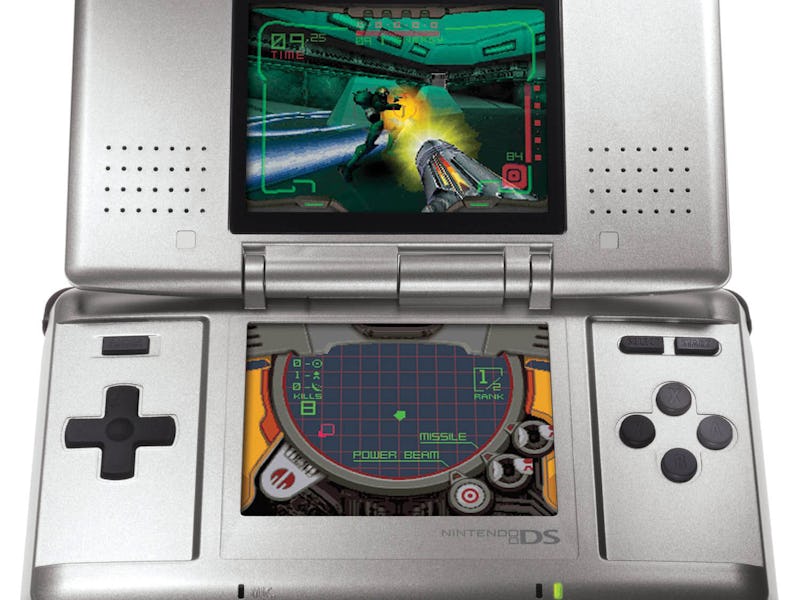Nintendo's Most Inventive Console Revealed Today's Weird Future
The DS created a roadmap for leaving the console wars.

When history repeats itself, it’s usually not fun. The phrase conjures images of failed conquests and fallen empires, victims of unlearned lessons. Sometimes, though, history repeats itself in a good way, as the lessons of the past are learned and internalized. And for the most famous video game company on the planet, history often reveals the future.
On November 21, 2004, the Nintendo DS launched into a gaming landscape awfully similar to the one Nintendo found itself in when releasing its first handheld, 1989’s Game Boy. In ‘89, common wisdom suggested it would have trouble competing against bigger, better handhelds made by Atari and Sega capable of impressive graphical displays. The Nintendo DS faced similar scrutiny as the long-awaited Sony portable, the PSP, was being developed simultaneously. In both cases, history proved Nintendo right, and the lessons learned shaped the company’s future.
The Nintendo DS became one of the most successful gaming platforms ever. With lifetime sales exceeding 154 million units worldwide, it remains the second-best-selling console in history, surpassed only by Sony's PlayStation 2. Its appeal stemmed from its groundbreaking dual screens and touch controls, and backward compatibility with Game Boy Advance titles, which offered players a unique experience while maintaining ties to Nintendo’s strong handheld legacy.
Introducing such groundbreaking features wasn’t a new move for Nintendo. There’s a direct line from legendary Nintendo designer Gunpei Yokoi, who spearheaded the Game Boy project, and the bells and whistles that made the DS a breakout success. Yokoi developed a design philosophy, Kareta Gijutsu no Suihei Shikō — loosely translated as “lateral thinking with withered technology” — that reasoned it was better to develop new uses for existing technology rather than engineer new tech.
Nintendo’s Game Boy became a success because of its technical limitations, not despite them. Atari and Sega dropped beefy handhelds capable of graphics teeming with colors. Nintendo gave consumers a dim, greyish-green screen. Why? Yokoi considered how to get the most from his batteries, not just his screen, giving the Game Boy a vastly superior battery life. The Nintendo DS would take a similar approach with its touchscreen.
Creative advertising helped gamers imagine the possibilities of a touchscreen interface.
It’s hard to imagine life without the touchscreen, but they were rare in 2004. It wasn’t exactly new or experimental technology, but it didn’t enjoy widespread adoption until Apple introduced the iPhone in 2007. Nintendo’s role in touchscreen proliferation is often overlooked, but based on volume alone, the DS made tens of millions of consumers comfortable with the tech.
It’s a clear example of Yokoi’s philosophy at work, and the feature-filled DS design reflects innovative thinking with similar technologies like microphones and styluses. The total picture of these combined features gives us a glimpse into what would become Nintendo’s future. As Nintendo of America President Reggie Fils-Aime explained in 2004, the DS showcased a new philosophy: the interface.
“What we are saying, and I passionately believe this, is that the future of gaming is about the interface and the innovation in the interface that we provide for gamers,” Fils-Aime said when the DS launched. “That's what's going to get the future gamers excited versus simply focusing on technology for technology's sake.”
Nintendo’s next three major consoles — the Wii, Wii U, and Switch — all put interface at the forefront of design. Most of these innovations, like the Wii’s motion controls and the Switch’s portability, generated a lot of excitement among fans, but the DS also found success with game developers.
Adding a useful second screen to a classic game immediately showed what the DS was capable of.
Critics approached the DS with skepticism, as its clamshell design and stylus-driven interface seemed unconventional. However, its launch titles quickly demonstrated the hardware’s potential. Super Mario 64 DS, a reimagining of the Nintendo 64 classic, showcased how the second screen could enhance gameplay with maps and touch-based controls. WarioWare: Touched! and Feel the Magic: XY/XX leaned into the device's design, delivering quirky, touch-focused experiences that appealed to early adopters.
A lineup of genre-defining titles soon followed. Games like Nintendogs targeted casual audiences, while Brain Age: Train Your Brain in Minutes a Day! and its sequel popularized “edutainment,” making the DS a hit with non-traditional gamers. The Pokémon series maintained its dominance, with Pokémon Diamond and Pearl selling over 17 million copies combined.
Mario Kart DS became a standout multiplayer experience, introducing online play to the series for the first time. The DS library of over 2,000 games included critically acclaimed entries such as The Legend of Zelda: Phantom Hourglass, Animal Crossing: Wild World, and New Super Mario Bros., the latter becoming the platform's best-selling game with over 30 million copies sold.
The Nintendo DS redefined handheld gaming and, with an interface-driven focus that popularized touchscreens, arguably set the stage for the smartphone revolution. It used the foundational principles that drove the Game Boy’s success and innovated in ways that would define Nintendo’s approach to the 21st century. It left rivals behind, content to let Microsoft and Sony fight their graphical arms race. With the Wii and the Switch, history repeated one of its most enduring lessons: the real winners in wars, console or otherwise, are the ones who never fight them.